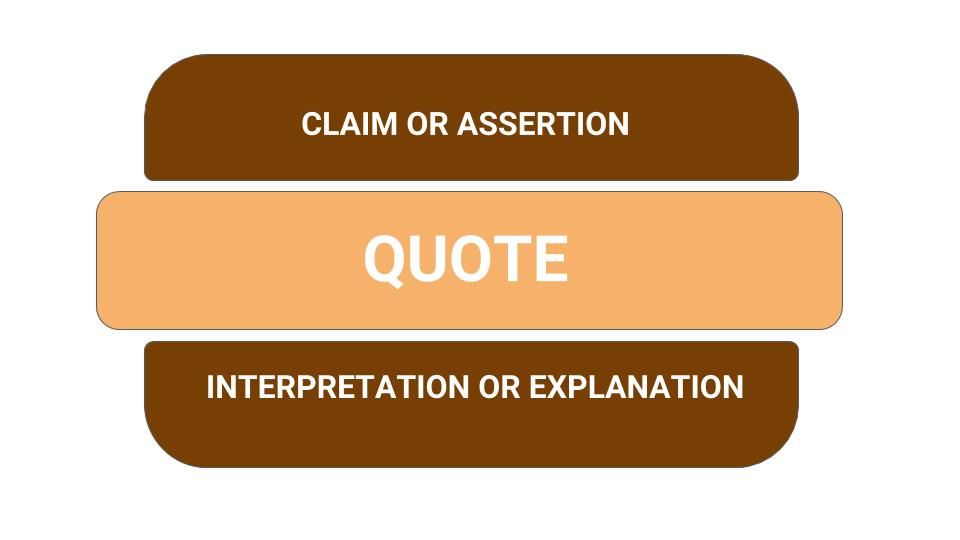6.2 THE BIG PICTURE: Using Outside Sources of Information
 A strong academic research essay needs strong evidence (proof). The credibility of your sources of outside information is one key part of this evidence. However, the way that you use outside sources of information is also important. Sometimes you’re citing a source that provides strong evidence for your point; at other times you’re summarizing someone else’s ideas in order to explain how your claim is different.
A strong academic research essay needs strong evidence (proof). The credibility of your sources of outside information is one key part of this evidence. However, the way that you use outside sources of information is also important. Sometimes you’re citing a source that provides strong evidence for your point; at other times you’re summarizing someone else’s ideas in order to explain how your claim is different.
When you think you found information useful for your academic research essay, stop and ask yourself these questions:
- Do you really understand the information from the outside source?
- How much of the information source do you need in your essay? A word or phrase? A sentence? A whole paragraph?
- Can you paraphrase the information? Or do you need to quote the author’s actual words?
When you are ready to proceed, remember this: Information from outside sources cannot stand alone. You must provide context to your paraphrase or quotation. You must help your reader see how the information is relevant and connected. One easy method is to make a “quotation sandwich.” This method makes sure that information from outside sources is always supporting your own ideas or claims, not taking their place.
The “quotation sandwich”
Writing an academic research essay is like having a conversation with outside sources of information. Just as with a friend or colleague, conversation is a two-way street. This is the “they say / I say” approach to academic writing. It’s a natural back and forth in which you use outsides sources to support your own claims — or as something to argue against — in order to illustrate a point. The “quotation sandwich” is one very effective way to do this. And here’s how it is done.
As you can imagine, most sandwiches have two pieces of bread with a filling in the middle. A “quotation sandwich” is similar. You, your voice, is the bread. The quote, your source’s voice, is the filling. When you put it all together, you’re providing your reader with the necessary context to understand why you are using the quote (relevance) and what it means to your thesis (implication).
Remember, quotes alone don’t make your point for you. Like your instructor, they can’t do your work for you; they can only help you. You have to do the heavy lifting by providing context.
Here’s another way to look at how to make the three ingredients of a “quotation sandwich”:
- The first sentence (the top layer of bread) is your claim that you want to make related to your thesis.
- The second sentence has two parts (think of it as the peanut butter and the jelly): the introduction to the quotation and the quotation itself
- The third sentence (the bottom layer of bread) is an interpretation or explanation of the quotation and how it relates to your claim
Let’s look at an example. Try to identify the three parts of this “quotation sandwich” below:
Great respect is often awarded to people who claim to have a lot of experience, but that experience is not necessarily always filled with success. The prolific Irish playwright and poet Oscar Wilde, for example, suggested that “Experience is simply the name we give our mistakes” (“BrainyQuote”). In other words, the wisdom that is associated with experience is based as much on a person’s failures as it is on their successes.
Works Cited
“BrainyQuote.” BrainyQuote, BrainyQuote, 2019, www.brainyquote.com/authors/oscar-wilde-quotes. Accessed 1 Dec. 2019.
Here’s the sample “quotation sandwich” again, this time with a description of each layer:
| Text | Description |
|---|---|
| Great respect is often awarded to people who claim to have a lot of experience, but that experience is not necessarily always filled with success. | The first sentence introduces my point: We respect people who have a lot of experience because we often equate experience with multiple successes; however, sometimes a person with a lot of experience has also failed many times. |
| The prolific Irish playwright Oscar Wilde, who arguably had as many flops onstage as hits, suggested that “Experience is simply the name we give our mistakes” (“BrainyQuote”). | In the second sentence, I begin to have a conversation with my outside source. This is the “they say” part of the “they say/I say” conversation. But I want to make sure you understand who the source is and why he is an authority on this. So I introduce him before actually giving the quotation. The order of these two elements is less important than the information it conveys. Finally, note that I have included an in-text citation in MLA format. |
| In other words, the wisdom that is associated with experience is based as much on a person’s failures as it is on their successes. | The third sentence provides an interpretation or explanation of the quote within the context of my argument or thesis. This is the “I say” part of the “they say/I say” conversation. Here, I’m answering the questions: What does it mean? Why am I telling my readers this? |
|
Works Cited “BrainyQuote.” BrainyQuote, BrainyQuote, 2019, www.brainyquote.com/authors/oscar-wilde-quotes. Accessed 1 Dec. 2019.
|
To practice MLA citation, I have also included the source reference as it would appear on a Works Cited page at the end of my essay. |
Verbs of attribution
Yourdictionary.com defines attribution as “the act of giving someone credit for doing something.” In the previous sentence, I used the verb “defines” as a verb of attribution. I wanted you to know who or what provided that information.
The verb “to say” does the job of attribution all right, but it’s neither precise nor interesting. And in a long essay with multiple quotes and paraphrases, repeated use of the same verb of attribution can be distracting and boring. Furthermore, some editors restrict the verb “to say” for use only when someone was actually uttered aloud, though in real life we tend to use it even when reporting written communication (for example, The red sign says “Stop.”).
Some common verbs of attribution include:
- states
- argues
- contends
- suggests
- claims
- offers
- writes
- answers
- asks
- relates
- asserts
- concludes
- points out
NOTE: All of these examples are in the present simple verb tense because we usually use the present simple verb tense when using information from outside sources. In some ways, that makes it easier for us to control verb form; however, we must remember to proofread carefully for subject-verb agreement (a singular subject requires a singular form of the verb, while a plural subject requires a plural form of the verb).
DISCUSSION
Quotation sandwiches are good for you and your writing! Let’s try to make some. First, watch the video below. Then think of your favorite quotation by a famous person or search the internet for one. Share that quotation here in the form of a quotation sandwich. Your should use at least three sentences:
- Some sort of claim that you want to make
- The quotation that supports your claim (including the person’s name)
- Your interpretation or explanation of the quotation
Text adapted from: Guptill, Amy. Writing in College: From Competence to Excellence. 2022. Open SUNY Textbooks, 2016, milneopentextbooks.org/writing-in-college-from-competence-to-excellence/. Accessed 16 Jan. 2022. CC BY-NC-SA
Video from: Gielissen, Theresa. “How to Do Quote Sandwiches.” www.youtube.com, 17 Nov. 2017, www.youtube.com/watch?v=z9qzqq1T6AM&feature=emb_imp_woyt. Accessed 17 Jan. 2022.


